Scottsdale Regenerative Medicine & Wellness provides personalized Stem Cell and Orthobiologic injections for each patient. In the practice of Orthopedics, Orthobiologics is defined as substances that can facilitate the healing of cartilage, bone, muscle, tendon, ligament and nerve.
Because each of us are different, so are the recommendations for your individual pain condition. Recommendations will be made on a case by case basis dependent upon your own specific condition. One or more Orthobiologic types of treatments may be recommended. There is a strong synergy or supportive benefit to combing more than one Orthobiologic treatment. Because “one size does not fit all” your recommendation will be made to your specific condition. Also, realize that ONE treatment does not mean than is all you will need. Dependent upon the severity of the condition, some patients need more than one Orthobiologic treatment.
Common Conditions Treated with Stem Cells and Orthobiologics
- Achilles Tear
- Achilles Tendonitis
- Ankle Pain & Arthritis
- Ankle Sprains
- Cartilage Damage
- Cervical Radiculitis
- Elbow Pain & Arthritis
- Elbow Pain
- Elbow Tendonitis
- Foot Pain & Arthritis
- Golfer’s Elbow
- Tendonitis
- Thoracic Pain
- Hand Pain & Arthritis
- Hip Arthritis
- Hip Pain
- Joint Laxity and Instability
- Knee Pain & Arthritis
|
- Knee Ligament Injuries
- Knee Tendonitis
- Ligament Tear
- Low Back Pain
- Neck Pain
- Patellar Tendonitis
- Tennis Elbow
- Wrist Pain & Arthritis
- Pelvic pain
- Plantar Fasciitis
- Rotator Cuff Tears
- Rotator Cuff Tendonitis
- Sacroiliac Joint Pain
- Sciatica
- Shoulder Pain & Arthritis
- Spinal Disc Problems
- Sprains & Strains
- Other Conditions Not Listed
|
Call us Today for a Complementary 15 minute Phone Consultation! (602) 292-2978
Regenerative Supershot/PRP
SuperShot/PRP is a treatment technique used to tighten and strengthen weak and damaged ligaments and tendons and cartilage which are believed to cause pain and instability. It is also used to decrease pain and improve function in some forms of arthritis. The technique requires the injection of Platelet Rich Plasma derived and exosomes from the patient’s own blood (autologous) according to standard blood collection and injection techniques.
Exosomes are derived from mesenchymal stem cells (MSC’s) and have similar functions such as repairing tissue damage, suppressing inflammatory responses, and modulating the immune system. Mesenchymal stem cells (MSCs) are among the most frequently used cell type in regenerative medicine for their ability to differentiate into different cell types such as cartilage cells, ligament cells, tendon cells, nerve cells, bone cells, and others.
Exosomes play important roles in cell-to-cell communication and exert positive effects on regeneration in many tissues. The exosomes isolated by SuperShot/PRP are Autologous and collected from the patient’s own Platelet-Poor Plasma. This eliminates any possible risk from commercial exosomes (allogenic exosomes) derived from someone else.
In a standard PRP preparation, whole blood is centrifuged into three components, separated by density: red blood cells, Platelet-Rich Plasma, and Platelet-Poor Plasma. In SuperShot/ PRP, the Platelet-Poor Plasma is centrifuged one additional time using the SuperShot/PRP patent-pending aqueous two-phase system, that precipitates low-density lipid-rich exosomes from the Plasma.

The exosomes isolated by SuperShot/PRP are added to the PRP, resulting significantly higher mesenchymal stem cell exosomes compared to allogeneic commercially prepared exosomes. Dependent upon each individual condition, more than one treatment may be necessary.
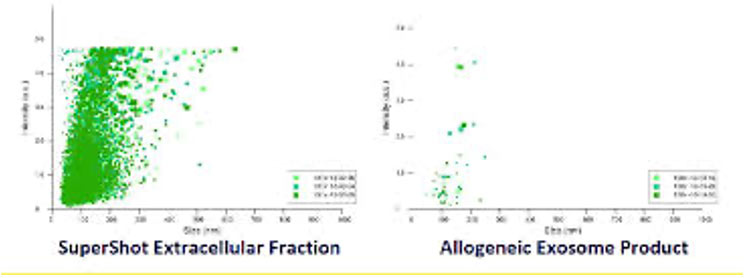
Advantages of SuperShot/PRP:
- Autologous: uses the patient’s own exosomes
- Nonsurgical procedure: this is an injection procedure
- More economical: commercially prepared exosomes are more expensive
- Higher number of Exosomes: a leading allogeneic mesenchymal stem cell exosome product contained just 0.6% pf the exosomes isolated by SuperShot/PRP
- Safe and easy to administer delivered in the same manner as other safe injection procedures
SuperShot/PRP is delivered in the same manner as other Regenerative Joint Injections. Due to the simplicity of the procedure, SuperShot/PRP is performed during a single office visit. Aftercare instructions are provided, and the patient drives home on their own.
Amniotic Tissue Allograft
The amniotic tissue is the innermost layer of the placenta. It has unique properties that make it useful for the treatment of painful musculoskeletal conditions. Amnion Tissue Allograft is a regenerative fluid that promotes regeneration and reduces pain. The different components include growth factors and cytokines that
- Stimulate tissue remodeling
- Stimulate blood vessel formation
- Reduce inflammation
- Stimulate antimicrobial activity
- Stimulate cell growth/formation
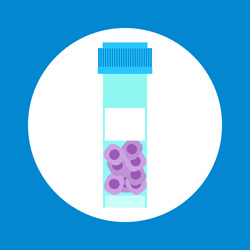
Amniotic Tissue: growth factors, cytokines, amino acids, carbohydrates, hyaluronic acid
The proteins in amniotic tissue may be used individually or in combination with other Orthobiologics to promote regeneration, reduce pain and provide a structural matrix for Bone Marrow Aspirate Concentrate (BMAC) and/or Platelet Rich Plasma (PRP). These proteins act as an anchor for the patient’s own cells and offers a scaffold for tissue reconstruction.
Advantages of Amniotic Tissue Allograft:
- Noninvasive harvesting procedure needed
- Immune Privileged with No Adverse Reactions
- Contents found in Amnion-derived fluid are found naturally in the body
- High growth factor production
The amniotic tissue allograft used by Scottsdale Pain Rehabilitation and Wellness is processed in accordance with all FDA guidelines and quality assurance measures in a controlled environment. All tissue products undergo strict safety screening and microbiological studies. This tissue is injected in and around a painful and degenerative joint to support and strengthen ligaments, tendons and cartilage.
It is controversial whether Amniotic fluid or tissue products contain living mesenchymal stem cell after the tissue has been commercially prepared. In a 2019 issue of The American Journal of Sports Medicine, the authors evaluated seven commercial companies that provide amniotic fluid stating “MCS’s could not be identified in the commercial AFPs (amniotic fluid preparation) or the unprocessed amniotic fluid. This study was unable to confirm that commercial AFP’s contain MSC’s”. 1
Reference:
- Panero Alberto, Hirahara Alan, Andersen Wyatt, et al, Are Amniotic Fluid Products Stem Cell Therapies? A Study of Amniotic fluid Preparations for Mesenchymal Stem Cells With Bone Marrow Comparison, The American Journal of Sports Medicine, March 2019.
Amniotic Tissue products do not appear to contain living mesenchymal stem cells; however, they do contain the components of these cells that promote regeneration and reduce musculoskeletal pain.
Call us Today for a Complementary 15 minute Phone Consultation! (602) 292-2978
Alpha-2-Macroglobulin (A2M)
Alpha-2-Macroglobulin (A2M) is protein found in relatively high concentration in your own blood plasma. A2M is used in the treatment of osteoarthritis (OA) to reduce pain and inflammation, block the breakdown of cartilage when treating painful joints. A2M attaches to and removes the destructive enzymes, proteases, that damage cartilage cells and tissues in the joint or disc space.
Clinical studies have shown positive results in treating a variety of different musculoskeletal areas in the body including plantar fasciitis, shoulder conditions, knee OA, hip OA, lumbar discs, elbow pain, ankle OA and wrist OA. A2M is gathered in the same manner that Platelet Rich Plasma is gathered with extra filtering and concentrating. Once the serum is separated from the platelets it is filtered to obtain a yellow fluid rich In A2M.
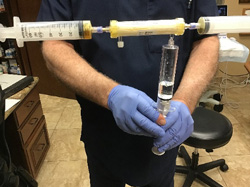
Collection Procedure for Alpha-2-Macroglobulin
This concentrated solution is then injected in or around the painful joint. A2M may be used as a single treatment or combined with PRP to reduce pain and promote healing regeneration.
Advantages of Alpha-2-Macroglobulin (A2M):
- Reduces inflammation and pain
- Prevents further breakdown of tissue
- Restores joint health
- Can be combined with PRP
- Safe and noninvasive procedure
A2M is a new and exciting approach for the treatment of osteoarthritis and painful joint. This new treatment provides an alternative to traditional orthopedic approaches including different drugs and surgery that can have ineffective and sometimes dangerous side effects.
What Can I Expect?
Because “one size does not fit all” your recommendation will be made to your specific condition. Also, realize that ONE treatment does not mean than is all you will need. Dependent upon the severity of the condition, some patients need more than one Orthobiologic treatment.
An “achy” soreness may be felt at the site of injury, just a few hours following the injection. This “soreness” is a positive sign that the healing response has been set in motion. This effect can last for several days and gradually decreases as healing and tissue repair occurs. Most patients will begin to see improvement approximately 1 to 2 months after treatment has been completed. Increased stability and strength are typically reported along with the decrease in pain. Recovery time and outcome will be dependent upon the structure treated and how chronic the problem. It may take 6-9 months for full regeneration to take place and more than one stem cell or orthobiologic procedure may be needed.
Of course, there is also the possibility that there will be no change in to pain pattern of the area treated.
Ultrasound Guided Injections
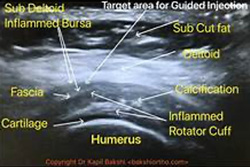
Ultrasound Image of the Shoulder
Stem cell and Orthobiologic regenerative joint injections may be performed with ultrasound guidance. This allows for exact visual identification of the treatment area, placement of the solution and diagnosis of the underlying structures such as tendons, ligaments and cartilage.
Regenerative Joint and Tissue IV
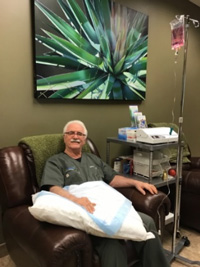
Dr. Fred Arnold receiving a Regenerative Joint & Tissue IV
This intravenous therapy (IV) is a specialized intravenous mixture of vitamins, minerals and amino acids to maximize the effects of Stem cell and all regenerative medicine injections. This specialized IV promotes the healing and regeneration of damaged and weakened tissues such as ligament, tendon and cartilage. With intravenous nutrition, the nutrients are delivered directly into the blood stream rather than being absorbed by the intestines. The time to complete the Regenerative Joint & Tissue IV is 2 hours.
Call us Today for a Complementary 15 minute Phone Consultation! (602) 292-2978